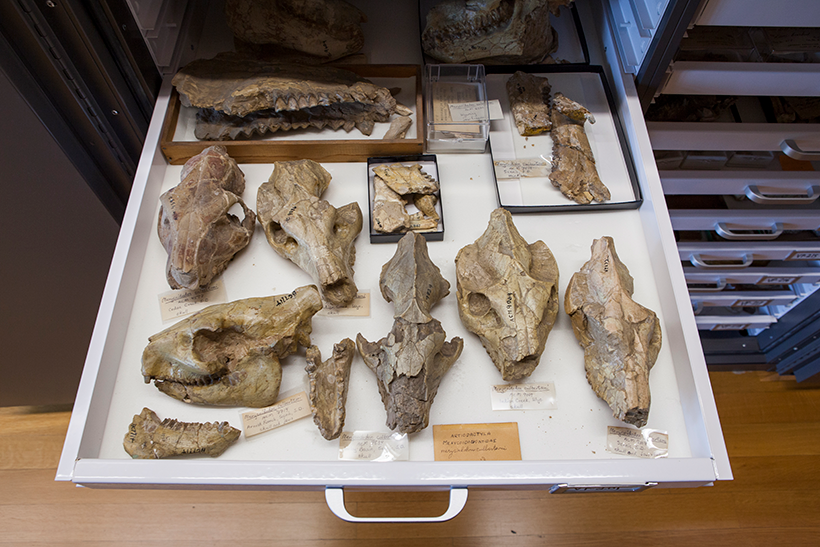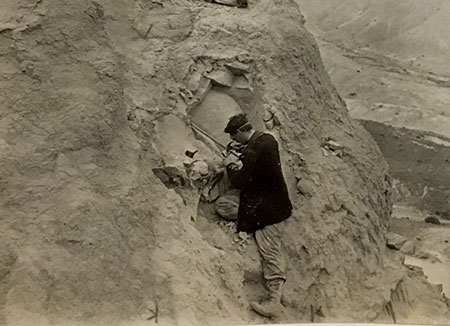Even on his year off, Frederic Brewster Loomis could not escape the dead.
The year was 1923, and this Amherst professor of geology, paleontology and biology—also a member of the class of 1896—was traveling south to Florida with his family, ostensibly “to enjoy the orange and grape fruit groves, the truck farms and sea beach.” But in Washington, D.C., the vacation morphed into a business trip when he visited the Smithsonian National Museum of Natural History. There he found a shipment of fossil reptiles from South Africa in need of a home. He promptly arranged for them to go to Amherst.
Nine hundred miles away and a year earlier, an orange grower in Melbourne, Fla., had discovered some unusual remains in a swamp on his property. He had reached out to scientists at the Smithsonian, where Loomis, during his stop in D.C., got wind of the find. On arriving in Florida, the professor got in touch with the grower, who invited him to stop by to have a look. At the swamp, Loomis declared the specimen to be “the teeth of the Columbian mammoth,” and, as he later recounted, “We all got busy and dug out nearly a complete skeleton.”
They set aside the skeleton for a local museum and returned to the dig, uncovering a second mammoth. That one would quickly become the centerpiece of Amherst’s natural history collection, housed at the time in Webster Hall. Now, almost a century later, the specimen has found renewed fame as the inspiration for the College’s mascot. The new mascot solidifies Loomis’s skeleton in a place of prominence at the College—and perhaps it will, over time, make Loomis as familiar a name as that of Edward Hitchcock, Amherst’s third president and collector of the Beneski Museum’s dinosaur tracks.
With the mammoth’s star now on the rise, it’s a good time to reassess the contributions of Loomis—a forgotten figure in paleontology. Without him, science—and Amherst in particular—would have many fewer fossil specimens. One of them, the lower jaw of a dinosaur, is the subject of a current research project that may soon reveal a new species. So let’s take another look at the popular professor who chatted his way into homes in Patagonia, who took undergraduates on harrowing digs, and whose sparse record-keeping sometimes frustrates modern paleontologists, who, according to one, have found more evidence of what the professor ate for lunch than where he collected his specimens.
Patagonia
One of the best-known—and best-documented—Loomis excursions was to Patagonia in 1911. Charles Darwin and others had already demonstrated that the region, encompassing 300,000 square miles of Argentina and 131,000 of Chile, harbored rich fossil deposits, especially of early mammals. Yet the vast area remained largely unexplored. “The Patagonia of our childhood geography was a no man’s land,” Loomis wrote in Hunting Extinct Animals in the Patagonian Pampas, his book documenting the trip. He wanted to determine whether the ancestors of modern horses, elephants and possibly even humans had originated there, an idea first put forth by Florentino Ameghino, an earlier paleontologist who worked extensively in Patagonia.
To help answer this question, Loomis brought along Waldo Shumway, class of 1911, and Philip Turner ’12, along with Billy Stein, an experienced fossil collector. Loomis’s Amherst classmates provided the funding. Departing on a steamship in July from New York, the professor and his team stopped in Rio de Janeiro, Montevideo and Buenos Aires to procure supplies. Next they bought horses near the coast in Argentina. On Aug. 20 they started their fieldwork.





